History
The building was constructed between 1657 and 1677 to a design by the architect Giovanni Antonio De Rossi on behalf of the marquises Giuseppe and Benedetto d’Aste. Little is known of the palace’s history in the following years until 1760, when it passed to the Florentine nobleman Folco Rinuccini, third marquis of Baselice. [1]
In 1818 the property was purchased, for the price of 27,000 gold piastres, [2] by Maria Letizia Ramolino, mother of the French Emperor Napoleon Bonaparte, who lived there until her death in 1836. Ramolino used to sit on the side balcony to admire the passage of carriages in the then St. Mark’s Square, enlisting the help of a lady-in-waiting when she became blind.
The heirs, the Bonaparte princes of Canino and Musignano, sold it in 1905 to the Marquises Misciatelli, while from 1972 it passed to the insurance company INA Assitalia, later acquired by Assicurazioni Generali in 2013.
Between 2017 and 2019, through the Valore e Cultura programme, Arthemisia, a company active in the field of exhibition organisation, set up its headquarters there following restoration and redevelopment of the building. [3]
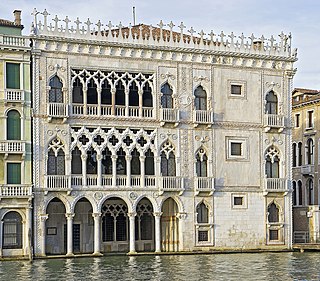
The Ca' d'Oro or Palazzo Santa Sofia is a palace on the Grand Canal in Venice, northern Italy. One of the older palaces in the city, its name means "golden house" due to the gilt and polychrome external decorations which once adorned its walls. Since 1927, it has been used as a museum, as the Galleria Giorgio Franchetti.
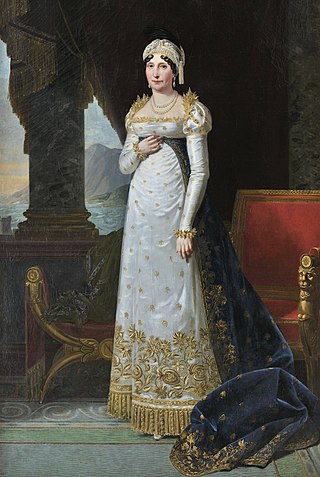
Maria-Letizia Bonaparte, known as Letizia Bonaparte, was a Corsican noblewoman and the mother of Napoleon I of France. She received the title "Madame Mère" due to her status as the Emperor's mother.

The Palazzo Venezia or Palazzo Barbo, formerly Palace of St. Mark, is a palazzo (palace) in central Rome, Italy, just north of the Capitoline Hill. The original structure of this great architectural complex consisted of a modest medieval house intended as the residence of the cardinals appointed to the church of San Marco. In 1469 it became a residential papal palace, having undergone a massive extension, and in 1564, Pope Pius IV, to win the sympathies of the Republic of Venice, gave the mansion to the Venetian embassy to Rome on the terms that part of the building would be kept as a residence for the cardinals, the Apartment Cibo, and that the republic would provide for the building's maintenance and future restoration. The palace faces Piazza Venezia and Via del Plebiscito. It currently houses the National Museum of the Palazzo Venezia.
Giovanni Antonio de' Rossi (1616–1695) was an Italian architect of the Baroque period, active mainly in Rome.

Palazzo Borghese is a palace in Rome, Italy, the main seat of the Borghese family. It was nicknamed il Cembalo due to its unusual trapezoidal groundplan; its narrowest facade faces the River Tiber. The entrance at the opposite end of the building, the "keyboard" of the cembalo, faces onto the Fontanella di Borghese, with another in a great flanking facade to the Piazza Borghese that is extended by a slightly angled facade leading down Via Borghese towards the river. Both these entrances lead into a large courtyard on one side of which is a two level open arcade, with paired Doric and Ionic columns, that frames the garden beyond.

The Palazzo Mancini is a palazzo in Rome, Italy. From 1737 to 1793 it was the second home of the French Academy in Rome. It is located on Via del Corso, about a block north of Piazza Venezia.
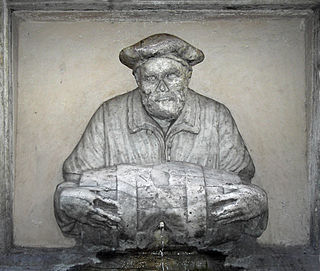
Il Facchino is one of the talking statues of Rome. Like the other five "talking statues", pasquinades - irreverent satires poking fun at public figures - were posted beside Il Facchino in the 14th and 15th centuries.

Villas and palaces in Milan are used to indicate public and private buildings in Milan of particular artistic and architectural value. Milan has always been an important centre with regard to the construction of historical villas and palaces, ranging from the Romanesque to the neo-Gothic, from Baroque to Rococo.
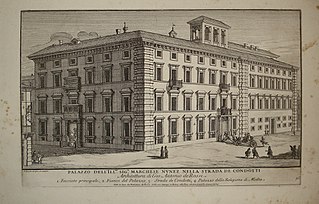
Palazzo Núñez-Torlonia is a palace in Rome, central Italy, the current home of the Torlonia family.

The Palace of Justice, colloquially nicknamed il Palazzaccio, is the seat of the Supreme Court of Cassation and the Judicial Public Library of Italy. It is located in the Prati district of Rome, facing Piazza dei Tribunali, Via Triboniano, Piazza Cavour, and Via Ulpiano.
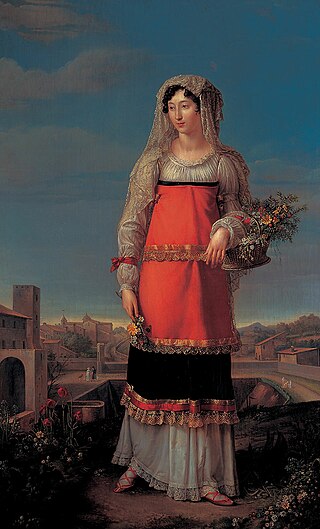
Filistine Charlotte Bonaparte Gabrielli was a French Napoleonic princess and the eldest daughter of Lucien Bonaparte and Christine Boyer. She became princess Gabrielli following her marriage to Mario Gabrielli, prince of Prossedi and Roccasecca, Duke of Pisterzo. In Italy, she was known as Carlotta.

Neoclassical architecture in Milan encompasses the main artistic movement from about 1750 to 1850 in this northern Italian city. From the final years of the reign of Maria Theresa of Austria, through the Napoleonic Kingdom of Italy and the European Restoration, Milan was in the forefront of a strong cultural and economic renaissance in which Neoclassicism was the dominant style, creating in Milan some of the most influential works in this style in Italy and across Europe. Notable developments include construction of the Teatro alla Scala, the restyled Royal Palace, and the Brera institutions including the Academy of Fine Arts, the Braidense Library and the Brera Astronomical Observatory. Neoclassicism also led to the development of monumental city gates, new squares and boulevards, as well as public gardens and private mansions. Latterly, two churches, San Tomaso in Terramara and San Carlo al Corso, were completed in Neoclassical style before the period came to an end in the late 1830s.

Corso Vittorio Emanuele II, commonly known as Corso Vittorio, is a wide east–west thoroughfare that courses through Rome. It connects a bridge over the Tiber, Ponte Vittorio Emanuele II, to both the Via Torre Argentina and Via del Plebiscito. The latter Via continues east from Piazza del Gesù and along Palazzo Venezia to reach Piazza Venezia which sits below the massive white Monument to Vittorio Emanuele II.

Piazza d'Aracoeli is a square of Rome (Italy), placed at the base of the Capitoline Hill, in the Rione X Campitelli.

Palazzo dei Convertendi is a reconstructed Renaissance palace in Rome. It originally faced the Piazza Scossacavalli, but was demolished and rebuilt along the north side of Via della Conciliazione, the wide avenue constructed between 1936 and 1950, which links St Peter's Basilica and the Vatican City to the centre of Rome. The palace is famous as the last home of the painter Raphael, who died there in 1520.
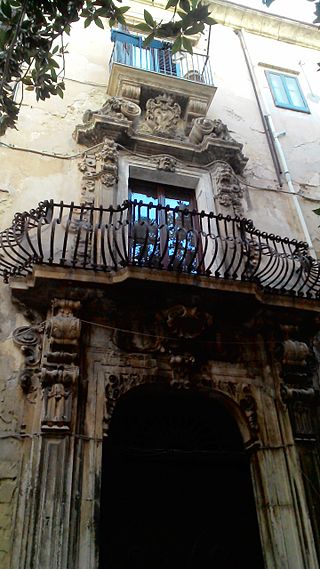
Palazzo Fraccia is a mansion in the town centre of Alcamo, in the province of Trapani.

Palazzo Donà Balbi is a palace in Venice, Italy, located in the Santa Croce district, overlooking the right side of the Grand Canal on the Riva di Biasio foundation opposite Palazzo Flangini and the church of San Geremia.

Palazzo Arese was a 16th century baroque palace and seat of a branch of the House of Arese in Milan, Italy. It was located adjacent to Casa Fontana Silvestri near the Porta Orientale. The palazzo was demolished in 1943 following damage sustained during the bombing of Milan in World War II.

Palazzo Mocenigo Gambara is a palace in Venice, located in the Dorsoduro district and overlooking the Grand Canal, between the Contarini Palazzi degli Scrigni and Corfù and Palazzo Querini alla Carità, not far from the Gallerie dell'Accademia and in front of Palazzo Giustinian Lolin.

Palazzo Corner Contarini dei Cavalli is a palace in Venice, located in the San Marco district, overlooking the left side of the Grand Canal, between the Rio di San Luca and Palazzo Grimani di San Luca on one side and Palazzo Tron and Palazzetto Tron Memmo on the other. The opposite structure is the Palazzo Papadopoli.




















